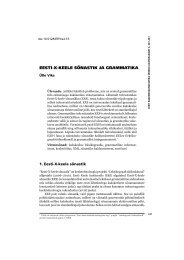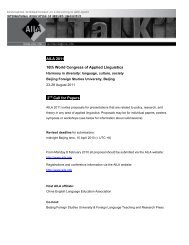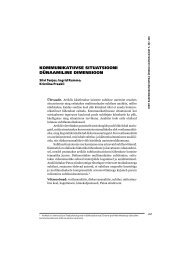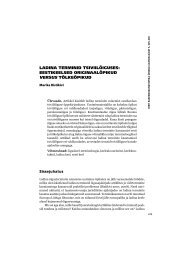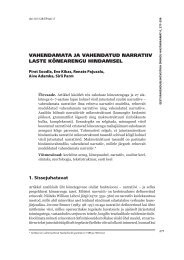ACQUISITION OF CASE IN LITHUANIAN AS L2: ERROR ANALYSIS
ACQUISITION OF CASE IN LITHUANIAN AS L2: ERROR ANALYSIS
ACQUISITION OF CASE IN LITHUANIAN AS L2: ERROR ANALYSIS
You also want an ePaper? Increase the reach of your titles
YUMPU automatically turns print PDFs into web optimized ePapers that Google loves.
(8) N!ra kiekio, bet viskas: SG:M:NOM [= visk#: SG:ACC] maišai, kol bus<br />
gražus tešla. (French)<br />
‘There is no amount, but mix everything until you get nice dough’<br />
(9) Aš atsibundu ir pradedu (iupin!ti savo burna: SG:F:NOM [= burn#:<br />
SG:ACC]. (Latvian)<br />
‘Then I wake up and start touching my mouth’<br />
In Examples (7)$(9) the nominative case is used instead of the required accusative.<br />
As the verbs vesti (‘to marry’), maišyti (‘to mix’), (iupin!ti (‘to touch’) are less<br />
frequently used, students nd it more difcult to remember what case these verbs<br />
require.<br />
3.1.2. The use of the nominative instead of the accusative<br />
(for time/duration)<br />
In the Lithuanian language duration is marked by the accusative case. However, <strong>L2</strong> 1<br />
learners sometimes use the nominative instead, as can be seen in Example (10):<br />
(10) Hansas dirbo septyni: PL:M:NOM metai: PL:M:NOM [= septynerius<br />
metus: ACC] už savo meistr# ir jis nor!jo eiti namo pas motin#. (German)<br />
‘Hans worked for seven years for his master and wanted to go home<br />
to his mother’<br />
The error of using the nominative case instead of the accusative in Example (10)<br />
might be inuenced by the student’s native tongue: in German a construction with<br />
the nominative 2 would also be appropriate to express time.<br />
3.1.3. The use of the nominative case instead of the genitive<br />
Research has shown that the genitive of quantiers is another cause of student dif-<br />
culty. In the Lithuanian language, the adverb daug (‘many, much’) requires the<br />
genitive case. The research data show that rather often students use the nominative<br />
if they do not know this rule. For example,<br />
(11) "ia yra daug pilys: PL:F:NOM [= pili%: PL:GEN]. (German)<br />
‘There are many castles here’<br />
(12) Lietuvoje yra daug g!l!s: PL:F:NOM ir daržov!s: PL:F:NOM [= g!li%:<br />
PL:GEN ir daržovi%: PL:GEN]. (English)<br />
‘In Lithuania there many owers and vegetables’<br />
Examples (11) and (12) indicate that students already understand the meaning of<br />
the adverb daug (‘many’), which is ‘more than one’. Thus they use the necessary<br />
plural of the noun to follow. However, the peculiarity of daug has not been acquired<br />
yet, thus students choose an inappropriate case form to represent the meaning.<br />
Similar errors are often made with other quantiers such as mažai (‘a little’), šiek<br />
tiek (‘some’), truput' (‘a little bit’), etc.<br />
52<br />
1<br />
In this paper, the abbreviation <strong>L2</strong> is used to refer to Lithuanian as a foreign language.<br />
2<br />
According to editors’ information, German would use the accusative here, e.g. Peter hat einen Tag (lang) auf Anna<br />
gewartet. (Grundzüge einer deutschen Grammatik. Berlin: Akademie Verlag, 1984, p. 411.) − Editor’s note.



